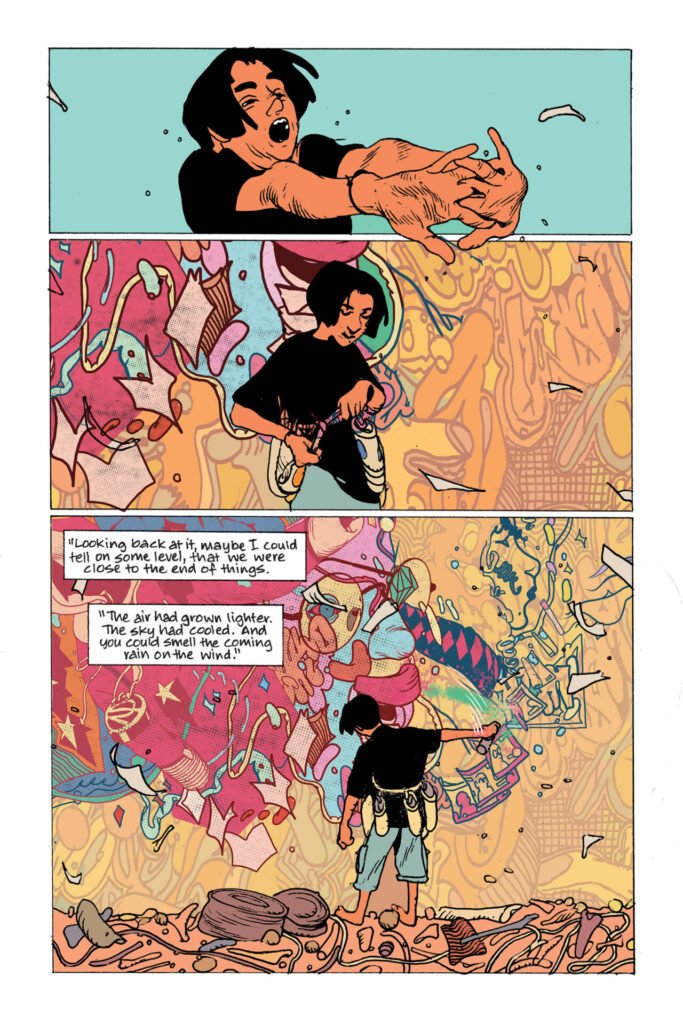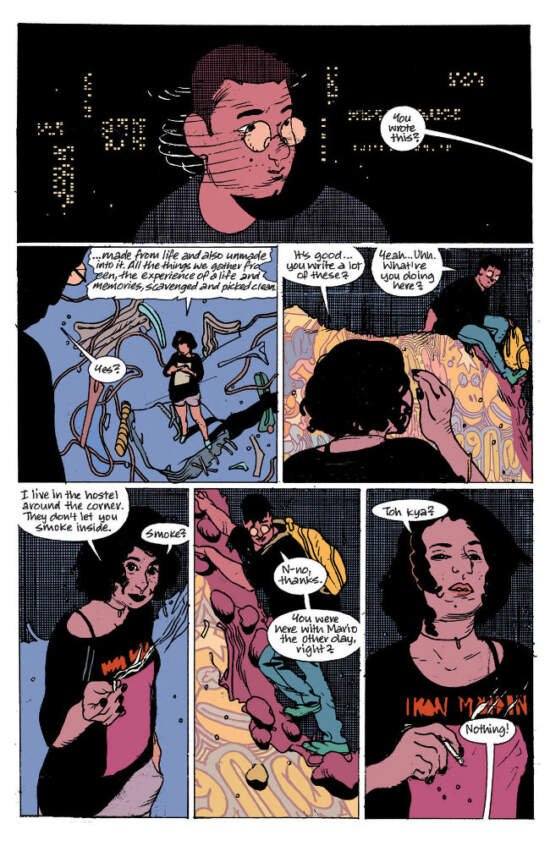Writer : Ram V
Artist : Anand Radhakrishnan
Publisher : Dark Horse
Year : 2018
A wall is supposed to be used to keep unwanted elements outside; these can either be the cold period of winter, the hellishly hot days of summer, or even creatures, ranging from dogs and cats (usually those which do not belong to us, whereas those who are part of our family are welcome) to those dreadful creatures that we call human beings.
Yet, a wall, like many other things, can change its function depending on the imagination it finds itself face to face; a piece of junk, after all, can easily acquire such worth it seems absurd to the untrained eye, as instances over instances of comic books which were being sold at a few cents are now being bought for thousands – if not tens of thousands – of dollars.
Walls, anyway, are not so lucky: apart from their normal usage, what usually happens is that they can become a canvas for people who want to express themselves; through the art of graffiti, that is.
Ram V’ s graphic novel tries to show us what life in present day Mumbai looks and feels like. The wall he paints on, the pages where he writes down the story, is matched by the wall used by Anand Radhakrishnan’s hands as they conjure up a world bursting with life, a city which never seems ready to stop. Yet, the rhythm of the work is such that we manage to move from chaos to silence in a matter of a few panels. The outer cosmos of tens of millions of people who try to survive in this anthill is counterbalanced by those moments of self-exile our characters go through as they find peace from chaos when they can finally be in front of a wall.
The overall movement of the work, then, is such that we end up being led by its internal rhythm towards an ending that expands on the possibilities of a time jump, making us feel that what we have just experienced is not the event, rather an event (or, better yet, a series of event) that are not to be taken as representative of all that could happen in such a metropolis.

We are made privy to the lives of four young characters, then, who try to balance the need for survival and the human drive (or necessity) towards making our dreams come true. There is, certainly, a kind of silent comment here on the meaning of dreams themselves. The problem is not that we all feel the crushing weight of reality hanging over our heads (or, worst case scenario, pushing us down on our back, a burden we’d like to shake off but can’t); the beauty of Ram’s message, in fact, is not that dreams can come true, rather that dreams are to be gained just as we need to accommodate our hopes in a world that many a time tramples on them.
In other words, the ending of the book is not what might at first appear to be, as it necessitates a deeper understanding of what is being told us. Characters grow, succeed in becoming what they are meant to be, while others change their path according to the kinds of opportunities that are available, without straying too much (just a little, perhaps) from their own desires.
Others, on the other hand, might simply leave us wondering whatever happened to them.
A Bildungsroman, the graphic novel is divided into four sections, plus one epilogue. The stories are interconnected and allow for a structure to repeat itself with those kind of variations that make each installment feel different. The structure, in fact, is that of presenting a character and make us understand him or her on a personal level, delving deeper into his or her world, therefore making space for what is an inner analysis that the writer and the artist pose against the backdrop of a society that seems to care little for anybody (there doesn’t seem to be a homo homini lupus feeling, rather the continuous presence of the idea of anonymity).
It’s a sequence of different points of view, then, all linked by the kind of frustration that can be experienced in a manner that leaves a mark – or a scar – on our psyche, conditioning perhaps our behaviour, and which our protagonists know they must overcome, somehow.

The aforementioned ending and its related feeling of having been reading a series of stories that are just a drop in Mumbai’s tumultuous life manage to create a sense of closure which is, at the same time, the recognition that what we have in our hands are just shards of something bigger (I refer here to the very lives of our characters). Yet, this intrusion into the space that lies behind a wall (or is it in front of it?) brings about a recognition of how life can differ when contextualized into places far away from and yet so similar to our own, as we share the same idiosyncrasies, the same hopes and the same lust and thirst for something better.
We don’t all want to become world-renowned artists, after all; we just want to leave our mark on a world that is part and parcel of our hopes, dreams and nightmares.
A graffiti on wall, perhaps, is just a way to make other people’s lives a bit better, and it’s all for free.

